Life-Cycle Assessments of Meat-Free and Meat-Containing Diets by Integrating Sustainability and Lean: Meat-Free Dishes Are Sustainable
Abstract
:1. Introduction
1.1. Research History
1.2. The Literature Review
1.3. Research Aims and Research Hypothesis
2. Materials and Methods
2.1. Data Collection
2.2. Life Cycle Assessment Method and System Boundary
2.3. Life-Cycle Inventory
2.4. Life-Cycle Impact Assessment Method and Functional Unit
2.5. Statistical Methods
2.6. Sustainability Assessment Modeling
3. Results
3.1. Energy Resources and Environmental Impacts of the Soups
3.2. Energy Resources and Environmental Impacts of the Main Dishes
3.3. Determination of Carbon Footprint Using Statistical Methods
3.4. Development of Sustainability Assessment Model (GreenCycLEAN)
4. Discussion
5. Conclusions
Author Contributions
Funding
Institutional Review Board Statement
Informed Consent Statement
Data Availability Statement
Conflicts of Interest
Abbreviations
| ADPE | Abiotic Depletion Potential elements |
| ADPF | Abiotic Depletion Potential fossils |
| AP | Acidification Potential |
| CE | Circular Economy |
| EGD | European Green Deal |
| EP | Eutrophication Potential |
| EU | European Union |
| FAETP | Freshwater Aquatic Ecotoxicity Potential |
| FU | Functional Unit |
| GWP | Global Warming Potential |
| HTP | Human Toxicity Potential |
| ILCD | International Reference Life-Cycle Data System |
| LCA | Life-Cycle Assessment |
| LCC | Life-Cycle Cost |
| LCI | Life-Cycle Inventory |
| LCIA | Life-Cycle Impact Assessment |
| POCP | Photochemical Ozone Creation Potential |
| SDGs | Sustainable Development Goals |
References
- United Nations Department of Economic and Social Affairs Statistics Division. Global Indicator Framework for the Sustainable Development Goals and Targets of the 2030 Agenda for Sustainable Development. Available online: https://unstats.un.org/sdgs/indicators/indicators-list (accessed on 15 October 2021).
- Eurostat Statistics Explained. Food Waste and Food Waste Prevention-Estimates. Available online: https://ec.europa.eu/eurostat/statistics-explained/index.php?title=Food_waste_and_food_waste_prevention_-_estimates (accessed on 1 March 2023).
- Stahel, W.R. Circular economy. Nature 2016, 531, 435–438. [Google Scholar] [CrossRef] [Green Version]
- D’Adamo, I. Adopting a Circular Economy: Current Practices and Future Perspectives. Soc. Sci. 2019, 8, 328. [Google Scholar] [CrossRef] [Green Version]
- D’Adamo, I.; Falcone, P.; Huisingh, D.; Morone, P. A circular economy model based on biomethane: What are the opportunities for the municipalty of Rome and beyond? Renew. Energy 2021, 163, 1660–1672. [Google Scholar] [CrossRef]
- Womack, J.; Jones, D.; Roos, D. The Machine That Changed the World: The Story of Lean Production, Toyota’s Secret Weapon in the Global Car Wars That Is Now Revolutionizing World Industry; Free Press: New York, NY, USA, 1990. [Google Scholar]
- Lipińska, M.; Tomaszewska, M.; Kołożyn-Krajewska, D. Identifying Factors Associated with Food Losses during Transportation: Potentials for Social Purposes. Sustainability 2019, 11, 2046. [Google Scholar] [CrossRef] [Green Version]
- Berggren, C. Lean Production-The End of History? Work. Employ. Soc. 1993, 7, 163–188. [Google Scholar]
- Sagnak, M.; Kazancogle, Y. Integration of green lean approach with six sigma an application for flue gas emissions. J. Clean. Prod. 2016, 127, 112–118. [Google Scholar] [CrossRef]
- Baca-Nomberto, A.; Urquizo-Cabala, M.; Ramos, E.; Sotelo-Raffo, F. A Model Utilizing Green Lean in Rice Crop Supply Chain: An Investigation in Piura, Perú. In Human Interaction, Emerging Technologies and Future Applications III. IHIET 2020. Advances in Intelligent Systems and Computing; Ahram, T., Taiar, R., Langlois, K., Choplin, A., Eds.; Springer: Cham, Switzerland, 2020; Volume 1253. [Google Scholar] [CrossRef]
- Sartal, A.; Martínez-Senra, A.; Cruz-Machado, V. Are all lean principles equally eco-friendly? A panel data study. J. Clean. Prod. 2018, 177, 362–370. [Google Scholar] [CrossRef]
- Melin, M.; Barth, H. Lean in Swedish agriculture: Strategic and operational perspectives. Prod. Plan. Control Manag. Oper. 2018, 29, 845–855. [Google Scholar] [CrossRef] [Green Version]
- Marqués, L.; Costa, L.; Gohr, C.F.; Carvalho, L.; Da Silva, M.H. Criteria and practices for lean and green performance assessment: A systematic review and conceptual framework. J. Clean. Prod. 2019, 218, 746–762. [Google Scholar] [CrossRef]
- Avató, J.L.; Mannheim, V. Life Cycle Assessment Model of a Catering Product: Comparing Environmental Impacts for Different End-of-Life Scenarios. Energies 2022, 15, 5423. [Google Scholar] [CrossRef]
- Rathi, R.; Kaswan, S.; Garza-Reyes, J.; Jiju, A.; Cross, J. Green Lean Six Sigma for improving manufacturing sustainability: Framework development and validation. J. Clean. Prod. 2022, 345, 131130. [Google Scholar] [CrossRef]
- Elemure, I.; Dhakal, H.; Leseure, M.; Radulovic, J. Integration of Lean Green and Sustainability in Manufacturing: A Review on Current State and Future Perspectives. Sustainability 2023, 15, 10261. [Google Scholar] [CrossRef]
- Rondanelli, M.; Gasparri, C.; Riva, A.; Petrangolini, G.; Barrile, G.C.; Cavioni, A.; Razza, C.; Tartara, A.; Perna, S. Diet and ideal food pyramid to prevent or support the treatment of diabetic retinopathy, age-related macular degeneration, and cataracts. Front. Med. 2023, 10, 1168560. [Google Scholar] [CrossRef] [PubMed]
- Naureen, Z.; Bonetti, G.; Medori, M.C.; Aquilanti, B.; Velluti, V.; Matera, G.; Iaconelli, A.; Bertelli, M. Foods of the Mediterranean diet: Lacto-fermented food, the food pyramid and food combinations. J. Prev. Med. Hyg. 2022, 63, 28–35. [Google Scholar] [CrossRef]
- Santos, L. The impact of nutrition and lifestyle modification on health. Eur. J. Int. Med. 2022, 97, 18–25. [Google Scholar] [CrossRef]
- Wilson, T.; Bendich, A. Nutrition Guidelines for Improved Clinical Care. Med. Clin. N. Am. 2022, 106, 819–836. [Google Scholar] [CrossRef]
- Santeramo, F.G.; Carlucci, D.; De Devitiis, B.; Seccia, A.; Stasi, A.; Viscecchia, R.; Nardone, G. Emerging trends. Food Res. Int. 2018, 104, 39–47. [Google Scholar] [CrossRef] [Green Version]
- OECD-FAO Agricultural Outlook 2021 OECD Agriculture Statistics (Database). Available online: https://www.fao.org/3/cb5332en/Meat.pdf (accessed on 16 December 2022).
- World Agriculture Towards 2030/2050. The 2012 Revision. Available online: https://www.fao.org/3/ap106e/ap106e.pdf (accessed on 16 December 2022).
- Jost, S.; Birringer, M.; Herzig, C. Brokers, prestige and information exchange in the European Union’s functional food sector—A policy network analysis. J. Funct. Foods 2022, 99, 105309. [Google Scholar] [CrossRef]
- Ahmad, I.; Hao, M.; Li, Y.; Zhang, J.; Ding, Y.; Lyu, F. Fortification of yogurt with bioactive functional foods and ingredients and associated challenges-A review. Trends Food Sci. Technol. 2022, 129, 558–580. [Google Scholar] [CrossRef]
- Cai, J.; Leung, P. Unlocking the potential of aquatic foods in global food security and nutrition: A missing piece under the lens of seafood liking index. Glob. Food Secur. 2022, 33, 100641. [Google Scholar] [CrossRef]
- Liu, C.; Ralston, N. Chapter Seven-Seafood and health: What you need to know? Adv. Food Nutr. Res. 2021, 97, 275–318. [Google Scholar] [CrossRef] [PubMed]
- Church, H.; Nagao-Sato, S.; Overcash, F.; Reicks, M. Associations between seafood intake frequency and diet and health indicators among U.S. adults: NHANES 2011–2016. J. Food Compos. Anal. 2021, 102, 104054. [Google Scholar] [CrossRef]
- Fehrenbach, G.; Pogue, R.; Carter, F.; Clifford, E.; Rowan, N. Implications for the seafood industry, consumers and the environment arising from contamination of shellfish with pharmaceuticals, plastics and potentially toxic elements: A case study from Irish waters with a global orientation. Sci. Total Environ. 2022, 844, 157067. [Google Scholar] [CrossRef]
- Iłowiecka, K.; Maslej, M.; Czajka, M.; Pawłowski, A.; Wieckowski, P.; Styk, T.; Gołkiewicz, M.; Kuzdralinski, A.; Koch, W. Lifestyle, Eating Habits, and Health Behaviors Among Dietary Supplement Users in Three European Countries. Front. Public Health 2022, 10, 892233. [Google Scholar] [CrossRef] [PubMed]
- Calderón, L.; Herrero, M.; Laca, A.; Díaz, M. Environmental impact of a traditional cooked dish at four different manufacturing scales: From ready meal industry and catering company to traditional restaurant and homemade. Int. J. Life Cycle Assess 2018, 23, 811–823. [Google Scholar] [CrossRef]
- Bruno, M.; Thomsen, M.; Pulselli, F.; Patrizi, N.; Marini, M.; Caro, D. The carbon footprint of Danish diets. Clim. Change 2019, 156, 489–507. [Google Scholar] [CrossRef]
- Filimonau, V.; Lemmer, C.; Marshall, D.; Bejjani, G. ‘Nudging’ as an architect of more responsible consumer choice in food service provision: The role of restaurant menu design. J. Clean. Prod. 2017, 144, 161–170. [Google Scholar] [CrossRef] [Green Version]
- Gormaz, T.; Cortés, S.; Tiboni-Oschilewski, O.; Weisstaub, G. The Chilean Diet: Is It Sustainable? Nutrients 2022, 14, 3103. [Google Scholar] [CrossRef]
- Wansink, B.; Love, K. Slim by design: Menu strategies for promoting high-margin, healthy foods. Int. J. Hosp. Manag. 2014, 42, 137–143. [Google Scholar] [CrossRef]
- Lawless, H.; Patel, A.; Lopez, N. Mixed messages: Ambiguous penalty information in modified restaurant menu items. Food Qual. Prefer. 2016, 52, 232–236. [Google Scholar] [CrossRef] [Green Version]
- Gerić, M.; Matković, K.; Gajski, G.; Rumbak, I.; Štancl, P.; Karlić, R.; Bituh, M. Adherence to Mediterranean Diet in Croatia: Lessons Learned Today for a Brighter Tomorrow. Nutrients 2022, 14, 3725. [Google Scholar] [CrossRef] [PubMed]
- Fry, J.P.; Stodden, B.; Brace, A.M.; Laestadius, L.I. A Tale of Two Urgent Food System Challenges: Comparative Analysis of Approaches to Reduce High-Meat Diets and Wasted Food as Covered in U.S. Newspapers. Sustainability 2022, 14, 12083. [Google Scholar] [CrossRef]
- Topcu, B.; Dias, G.M.; Mollaei, S. Ten-Year Changes in Global Warming Potential of Dietary Patterns Based on Food Consumption in Ontario, Canada. Sustainability 2022, 14, 6290. [Google Scholar] [CrossRef]
- Houghtaling, B.; Greene, M.; Parab, K.V.; Singleton, C.R. Improving Fruit and Vegetable Accessibility, Purchasing, and Consumption to Advance Nutrition Security and Health Equity in the United States. Int. J. Environ. Res. Public Health 2022, 19, 11220. [Google Scholar] [CrossRef] [PubMed]
- Camilleri, M.A. Sustainable Production and Consumption of Food. Mise-en-Place Circular Economy Policies and Waste Management Practices in Tourism Cities. Sustainability 2021, 13, 9986. [Google Scholar] [CrossRef]
- Ioannou, T.; Bazigou, K.; Katsigianni, A.; Fotiadis, M.; Chroni, C.; Manios, T.; Daliakopoulos, I.; Tsompanidis, C.; Michalodimitraki, E.; Lasaridi, K. The “A2UFood Training Kit”: Participatory Workshops to Minimize Food Loss and Waste. Sustainability 2022, 14, 2446. [Google Scholar] [CrossRef]
- Brändström, J.; Saidani, M. Comparison between circularity metrics and LCA: A case study on circular economy strategies. J. Clean. Prod. 2022, 371, 133537. [Google Scholar] [CrossRef]
- Erdiaw-Kwasie, M.; Abunyewah, M.; Yusife, S.; Erdiaw-Kwasief, A. Does circular economy knowledge matter in sustainable service provision? A moderation analysis. J. Clean. Prod. 2023, 383, 135429. [Google Scholar] [CrossRef]
- Bianchi, M.; Cordella, M. Does circular economy mitigate the extraction of natural resources? Empirical evidence based on analysis of 28 European economies over the past decade. Ecol. Econ. 2023, 203, 107607. [Google Scholar] [CrossRef]
- Bongers, A.; Casas, P. The circular economy and the optimal recycling rate: A macroeconomic approach. Ecol. Econ. 2022, 199, 107504. [Google Scholar] [CrossRef]
- Kustar, A.; Patino-Echeverri, D. A Review of Environmental Life Cycle Assessments of Diets: Plant-Based Solutions Are Truly Sustainable, even in the Form of Fast Foods. Sustainability 2021, 13, 9926. [Google Scholar] [CrossRef]
- Kowalski, Z.; Muradin, M.; Kulczycka, J.; Makara, A. Comparative Analysis of Meat Bone Meal and Meat Bone Combustion Using the Life Cycle Assessment Method. Energies 2021, 14, 3292. [Google Scholar] [CrossRef]
- Purvis, B.; Mao, Y.; Robinson, D. Three pillars of sustainability: In search of conceptual origins. Sustain. Sci. 2019, 14, 681–695. [Google Scholar] [CrossRef] [Green Version]
- Stiles, G.; Collins, J.; Beck, K. Effectiveness of Strategies to Decrease Animal-Sourced Protein and/or Increase Plant-Sourced Protein in Foodservice Settings: A Systematic Literature Review. J. Acad. Nutr. Diet. 2022, 122, 5. [Google Scholar] [CrossRef] [PubMed]
- Rizwan, M.; Abbas, A.; Xu, H.; Ahmed, U.I.; Qing, P.; He, P.; Iqbal, M.A.; Shahzad, M.A. Role of Nutrition Information in Acceptance and Willingness to Pay for Biofortified Cereal Food: Implications for Better Health and Sustainable Diet. Nutrients 2022, 14, 3352. [Google Scholar] [CrossRef]
- Wijerathna-Yapa, A.; Pathirana, R. Sustainable Agro-Food Systems for Addressing Climate Change and Food Security. Agriculture 2022, 12, 1554. [Google Scholar] [CrossRef]
- Zuin, V.G.; Araripe, E.; Zanotti, K.; Stahl, A.M.; Gomes, C.J.C. Alternative Products Selling Sustainability? A Brazilian Case Study on Materials and Processes to Produce Plant-Based Hamburger Patties. Sustain. Chem. 2022, 3, 415–429. [Google Scholar] [CrossRef]
- Alexandropoulou, I.; Goulis, D.G.; Merou, T.; Vassilakou, T.; Bogdanos, D.P.; Grammatikopoulou, M.G. Basics of Sustainable Diets and Tools for Assessing Dietary Sustainability: A Primer for Researchers and Policy Actors. Healthcare 2022, 10, 1668. [Google Scholar] [CrossRef]
- Harray, A.J.; Boushey, C.J.; Pollard, C.M.; Dhaliwal, S.S.; Mukhtar, S.A.; Delp, E.J.; Kerr, D.A. Healthy and Sustainable Diet Index: Development, Application and Evaluation Using Image-Based Food Records. Nutrients 2022, 14, 3838. [Google Scholar] [CrossRef]
- Pereira, A.G.; Fraga-Corral, M.; Garcia-Oliveira, P.; Otero, P.; Soria-Lopez, A.; Cassani, L.; Cao, H.; Xiao, J.; Prieto, M.A.; Simal-Gandara, J. Single-Cell Proteins Obtained by Circular Economy Intended as a Feed Ingredient in Aquaculture. Foods 2022, 11, 2831. [Google Scholar] [CrossRef]
- Wahab, A.; Mukhtar, M.; Sulaiman, R. A Conceptual Model of Lean Manufacturing Dimensions. Procedia Technol. 2013, 11, 1292–1298. [Google Scholar] [CrossRef] [Green Version]
- Fiorello, M.; Gladysz, B.; Corti, D.; Wybraniak-Kujawa, M.; Ejsmont, K.; Sorlini, M. Towards a smart lean green production paradigm to improve operational performance. J. Clean. Prod. 2023, 413, 137418. [Google Scholar] [CrossRef]
- Abu Musameh, S.; Alqedra, M.; Arafa, M.; Agha, S. Developing a Framework for Implementing Green- Lean Construction Techniques. J. Eng. Res. Technol. 2018, 5, 77–87. [Google Scholar]
- Vinci, G.; Maddaloni, L.; Prencipe, S.A.; Ruggeri, M.; Di Loreto, M.V. A Comparison of the Mediterranean Diet and Current Food Patterns in Italy: A Life Cycle Thinking Approach for a Sustainable Consumption. Int. J. Environ. Res. Public Health 2022, 19, 12274. [Google Scholar] [CrossRef]
- Nunes, B.; Bennett, D. Green operations initiatives in the automotive industry: An environmental reports analysis and benchmarking study. Benchmarking Int. J. 2010, 17, 396–420. [Google Scholar] [CrossRef]
- Srivastava, S.; Raniga, U.I.; Misra, S. A Methodological Framework for Life Cycle Sustainability Assessment of Construction Projects Incorporating TBL and Decoupling Principles. Sustainability 2022, 14, 197. [Google Scholar] [CrossRef]
- Kalakul, S.; Malakul, P.; Siemanond, K.; Gani, R. Integration of life cycle assessment software with tools for economic and sustainability analyses and process simulation for sustainable process design. J. Clean. Prod. 2014, 71, 98–109. [Google Scholar] [CrossRef]
- ISO 14040:2006; Environmental Management—Life Cycle Assessment—Principles and Framework. ISO: Geneva, Switzerland, 2006.
- ISO 14044:2006; Environmental Management—Life Cycle Assessment—Requirements and Guidelines. ISO: Geneva, Switzerland, 2006.
- Van Oers, L.; De Koning, A.; Guinée, J.B.; Huppes, G. Abiotic resource depletion in LCA. In Improving Characterisation Factors for Abiotic Resource Depletion as Recommended in the New Dutch LCA Handbook; RWS-DWW: Delft, The Netherlands, 2002; Available online: http://www.leidenuniv.nl/cml/ssp/projects/lca2/report_abiotic_depletion_web.pdf (accessed on 29 February 2016).
- Kupfer, T.; Baitz, M.; Colodel, C.M.; Kokborg, M.; Schöll, S.; Rudolf, M.; Thellier, L.; Bos, U.; Bosch, F.; Gonzalez, M. GaBi Database & Modeling Principles. In GaBi Thinkstep AG; Sphera: Chicago, IL, USA, 2018. [Google Scholar]
- CML; Institute of Environmental Sciences, Leiden University. CML-IA Characterisation Factors Portal. 2016. Available online: https://www.universiteitleiden.nl/en/research/researchoutput/science/cml-ia-characterisation-factors (accessed on 29 June 2018).
- The Global Risks Report 2020; The World Economic Forum: Geneva, Switzerland, 2020; Available online: https://www.weforum.org/reports/the-global-risks-report-2020 (accessed on 15 October 2021).
- Kaczmarczyk, B.; Urych, I. Perception of the Transition to a Zero-Emission Economy in the Opinion of Polish Students. Energies 2022, 15, 1102. [Google Scholar] [CrossRef]
- Bałdowska-Witos, P.; Kruszelnicka, W.; Tomporowski, A. LCA analyzes were also performed for the production of PET bottle. Life cycle assessment of beverage bottles. J. Phys. Conf. Ser. 2020, 1426, 012038. [Google Scholar] [CrossRef]
- Mannheim, V. Life Cycle Assessment Model of Plastic Products: Comparing Environmental Impacts for Different Scenarios in the Production Stage. Polymers 2021, 13, 777. [Google Scholar] [CrossRef] [PubMed]
- Bianco, I.; Panepinto, D.; Zanetti, M. End-of-Life Tyres: Comparative Life Cycle Assessment of Treatment Scenarios. Appl. Sci. 2021, 11, 3599. [Google Scholar] [CrossRef]
- Alwaeli, M.; Mannheim, V. Investigation into the Current State of Nuclear Energy and Nuclear Waste Management—A State-of-the-Art Review. Energies 2022, 15, 4275. [Google Scholar] [CrossRef]
- Civancik-Uslu, D.; Puig, R.; Ferrer, L.; Fullana-i-Palmer, P. Influence of end-of-life allocation, credits and other methodological issues in LCA of compounds: An in-company circular economy case study on packaging. J. Clean. Prod. 2019, 212, 925–940. [Google Scholar] [CrossRef]
- Kiss, N.É.; Tamás, J.; Szőllősi, N.; Gorliczay, E.; Nagy, A. Assessment of Composted Pelletized Poultry Litter as an Alternative to Chemical Fertilizers Based on the Environmental Impact of Their Production. Agriculture 2021, 11, 1130. [Google Scholar] [CrossRef]
- Szita, K. The Application of Life Cycle Assessment in Circular Economy. Hung. Agric. Eng. 2017, 31, 5–9. [Google Scholar] [CrossRef]
- Salehin, M.; Kiss, J.T. Testing the Causal Relationship between Economic Growth and Renewable Energy Consumption: Evidence from a Panel of EAGLE Countries. Int. J. Energy Econ. Policy 2022, 12, 281–288. [Google Scholar] [CrossRef]
- Muñoz, L. Sustainability thoughts 127: Pareto optimality under the sustainability eye: Is the traditional pareto efficient bundle the second most undesirable bundle on the pareto optimality sustainability line? If yes, why? Int. J. Manag. Stud. Soc. Sci. Res. 2021, 3, 180–196. [Google Scholar]
- Jiang, S.; Zhang, H.; Cong, W.; Liang, Z.; Ren, Q.; Wang, C.; Zhang, F.; Jiao, X. Multi-Objective Optimization of Smallholder Apple Production: Lessons from the Bohai Bay Region. Sustainability 2020, 12, 6496. [Google Scholar] [CrossRef]
- Enea, M.; Salei, G. Fuzzy approach to the environmental impact evaluation. Ecol. Model. 2001, 135, 131–147. [Google Scholar] [CrossRef]
- Peche, R.; Rodríguez, E. Environmental impact assessment procedure: A new approach based on fuzzy logic. Environ. Impact Assess. Rev. 2009, 29, 275–283. [Google Scholar] [CrossRef]
- Mannheim, V.; Kruszelnicka, W. Energy-Model and Life Cycle-Model for Grinding Processes of Limestone Products. Energies 2022, 15, 3816. [Google Scholar] [CrossRef]
- Mannheim, V.; Kruszelnicka, W. Relation between Scale-Up and Life Cycle Assessment for Wet Grinding Process of Pumice. Energies 2023, 16, 4470. [Google Scholar] [CrossRef]
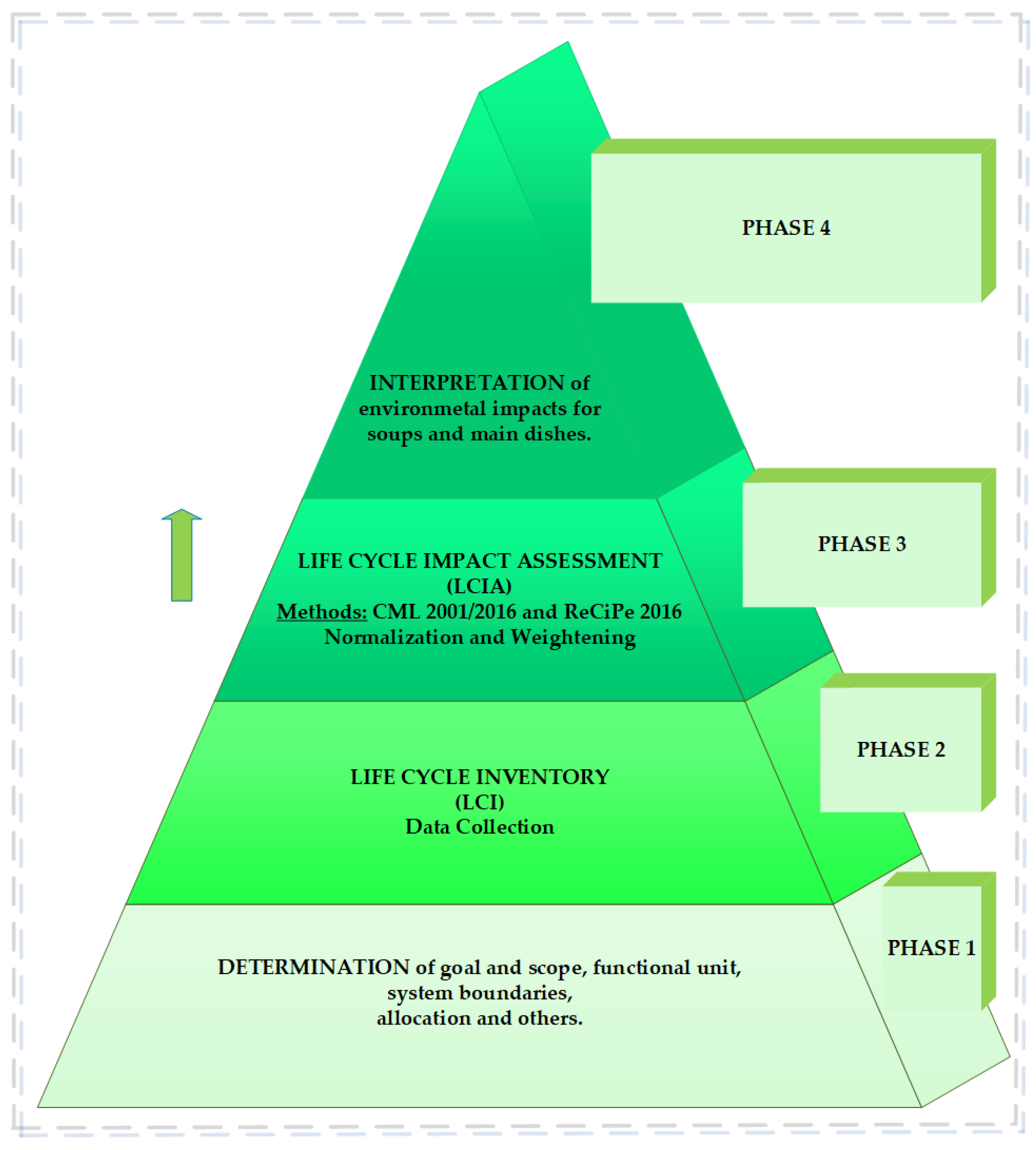
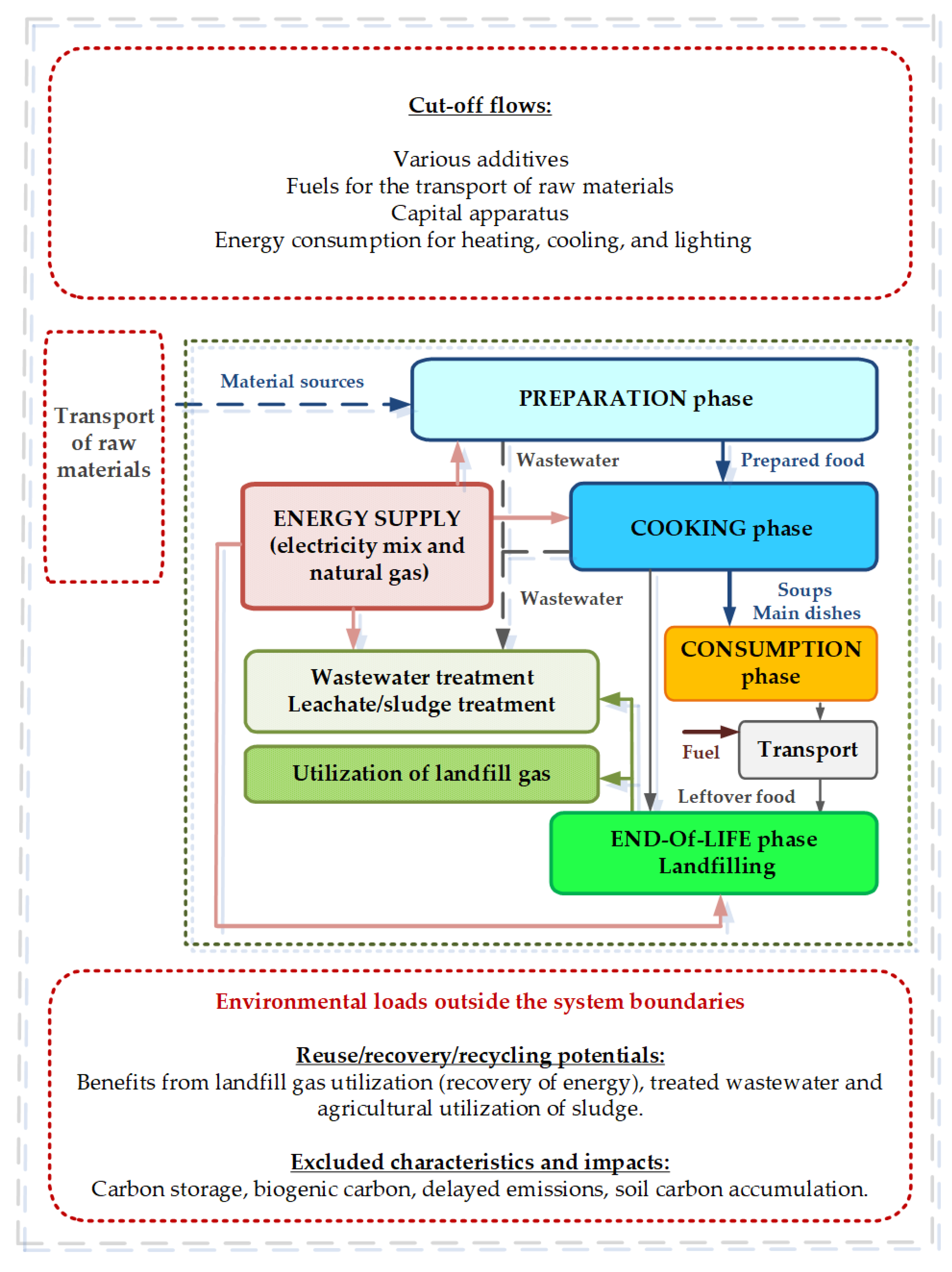
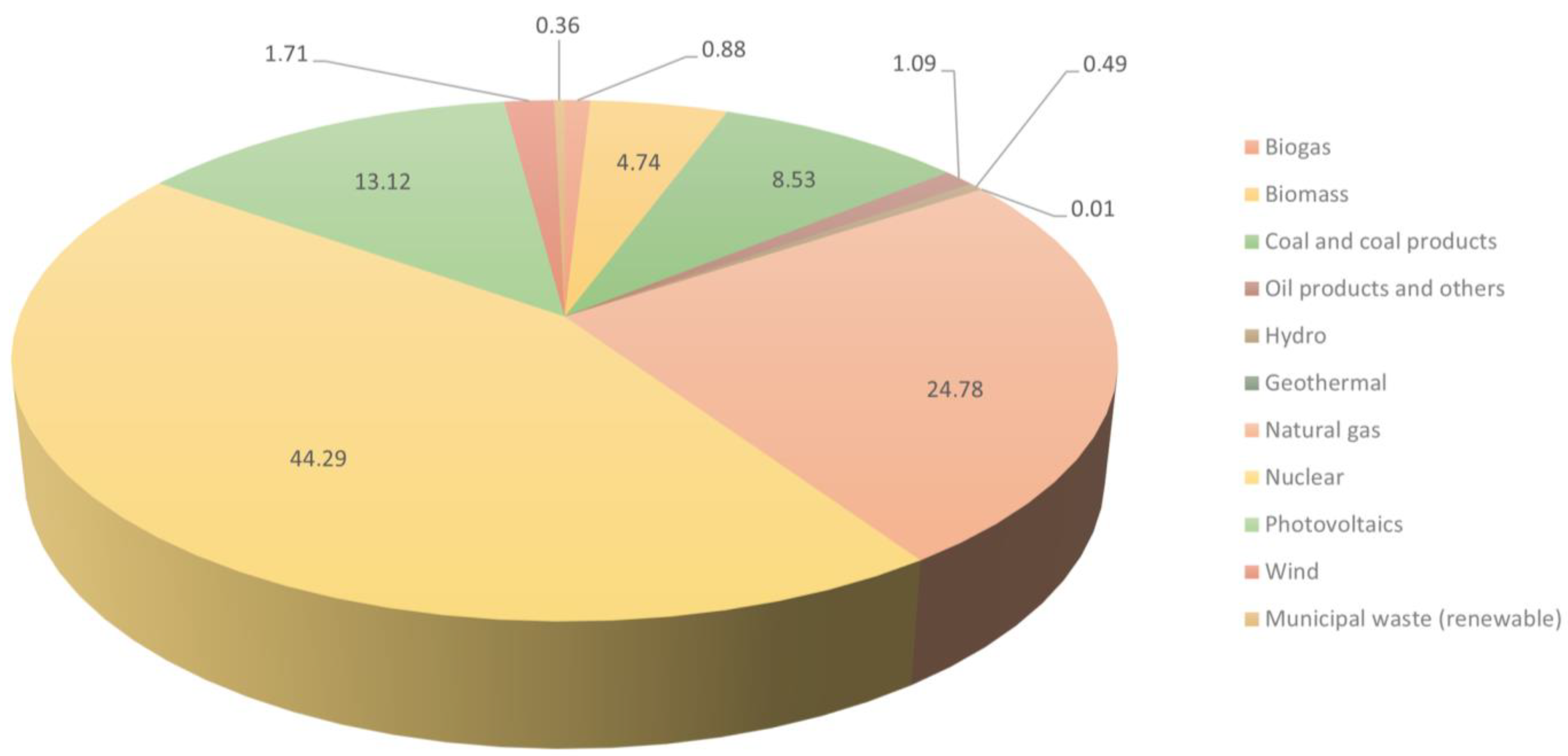
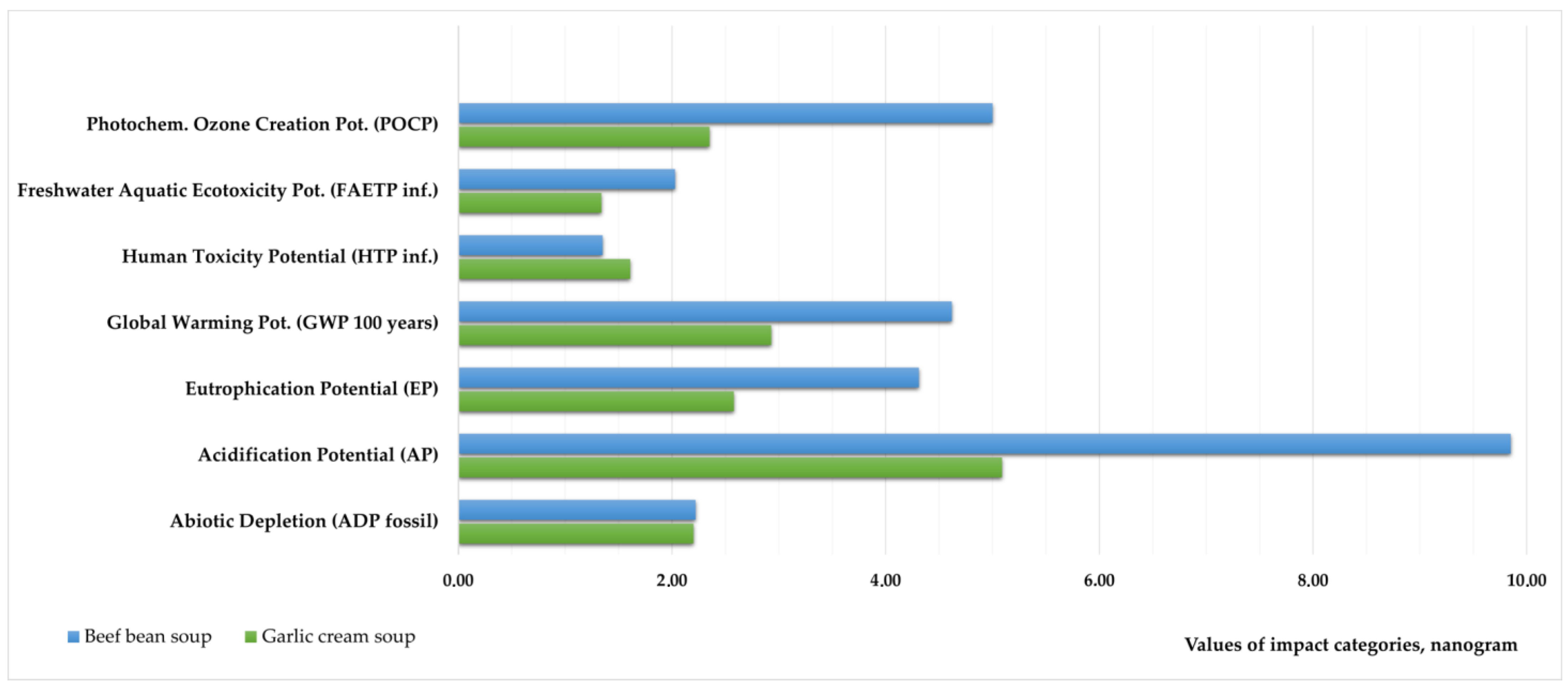
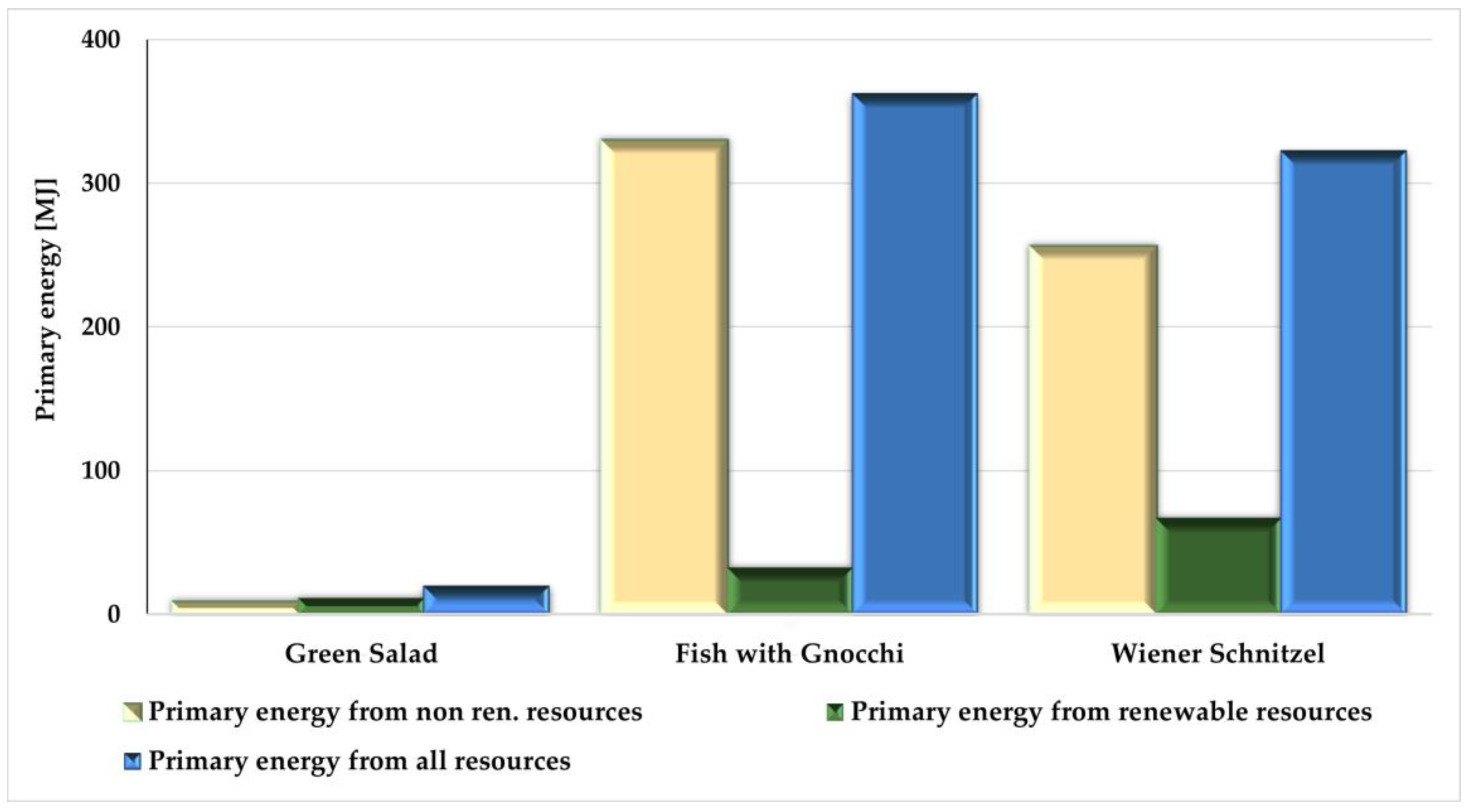
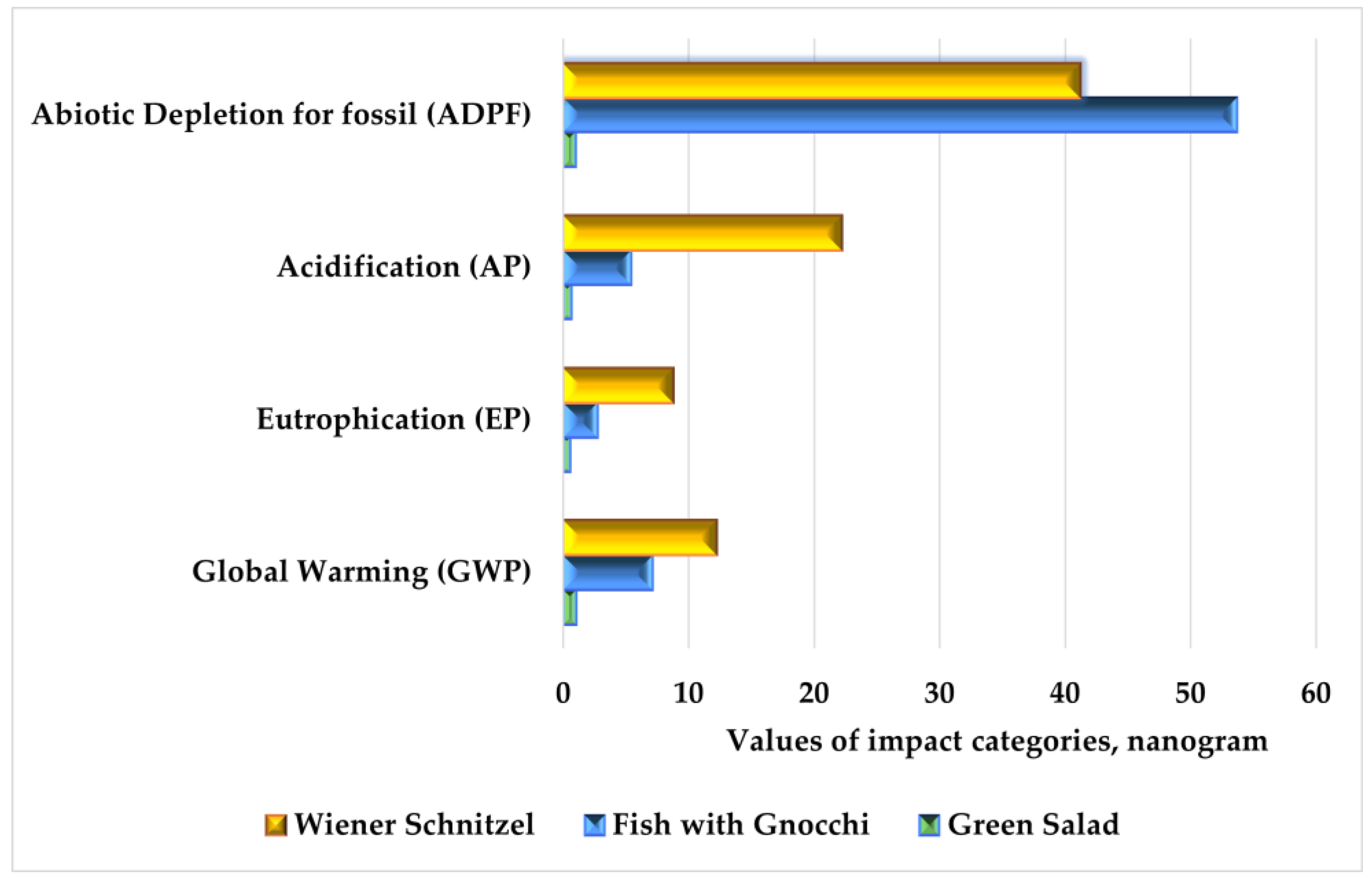

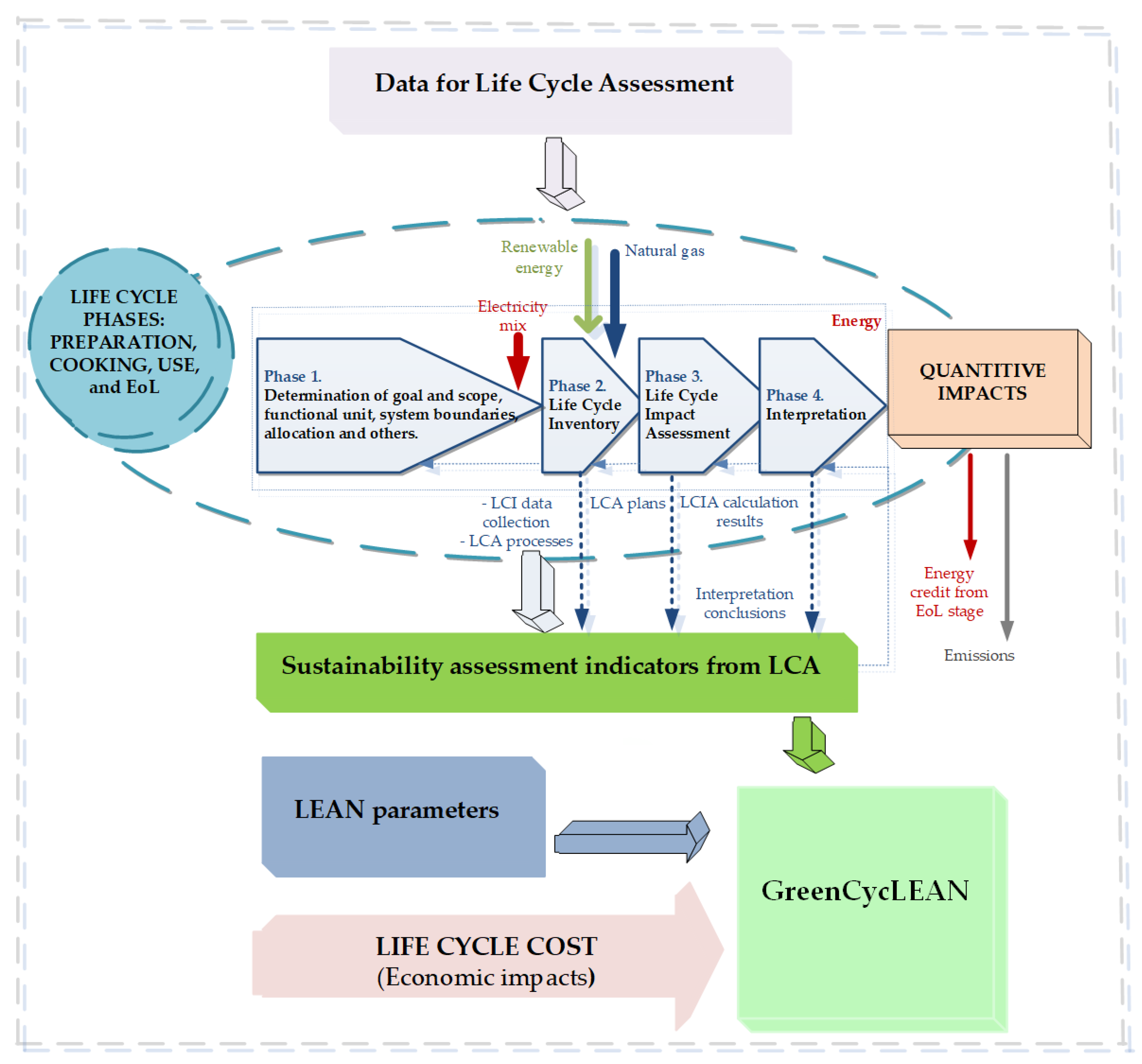
| Flow Type | Process Flow Name | Plan Flow Name |
|---|---|---|
| Garlic Cream Soup | ||
| Inputs | Cheddar | Cheddar |
| Garlic | Garlic | |
| Pasteurized cream (42%) | Pasteurized cream (38–42%) | |
| Rapeseed oil (Canola) | Rapeseed oil, refined | |
| Wheat white flour | Wheat white flour | |
| Beef Bean Soup | ||
| Inputs | Beef cattle | Beef, semi-boneless |
| Beans at farm | Field beans, field border (14% water content) | |
| Carrots (87% water content) | Carrots | |
| Cream (38%) | Pasteurized cream (38–42%) | |
| Sugar beet (75% water content) | Celery tuber, garlic, and onion | |
| Green Salad | ||
| Inputs | Carrots (87% water content) | Carrots |
| Rapeseed oil (Canola) | Rapeseed oil, refined | |
| Sugar beet (75% water content) | Onion | |
| Sunflower seeds | Sunflower seeds | |
| Tomato (97% water content) | Tomato | |
| Fish with Gnocchi | ||
| Inputs | Fish meal | Fish meal |
| Orange (90% water content) | Orange | |
| Pasteurized cream (42%) | Pasteurized cream (38–42%) | |
| Potato at farm | Potato | |
| Rapeseed oil (Canola) | Rapeseed oil, refined | |
| Wheat white flour | Wheat white flour | |
| Wiener Schnitzel | ||
| Inputs | Beef cattle | Beef, semi-boneless |
| Egg, breadcrumb | Egg, breadcrumb | |
| Orange (90% water content) | Orange | |
| Potato at farm | Potato | |
| Rapeseed oil (Canola) | Rapeseed oil, refined | |
| Wheat white flour | Wheat white flour | |
| Process Flow Name | Plan Flow Name | Amount for 1 Portion/for 1 kg [kg] |
|---|---|---|
| Garlic Cream Soup (1 portion) | ||
| Water (drinking water) | Drinking water (EU mix) | 4.50/27.13 |
| Beef Bean Soup (1 portion) | ||
| Water (drinking water) | Drinking water (EU mix) | 7.00/15.54 |
| Green salad (1 portion) | ||
| Water (drinking water) | Drinking water (EU mix) | 5.00/15.43 |
| Fish with gnocchi (1 portion) | ||
| Water (drinking water) | Drinking water (EU mix) | 8.00/16.51 |
| Wiener Schnitzel (1 portion) | ||
| Water (drinking water) | Drinking water (EU mix) | 8.50/19.76 |
| Flow Type | Process Flow Name | Plan Flow Name | Amount for 1 Portion/for 1 kg [MJ] |
|---|---|---|---|
| Garlic Cream Soup (1 portion) | |||
| Input | Hungarian electricity mix | Electricity grid mix (production mix, Hungary) | 0.85/5.12 |
| Natural gas at consumer (Hungary) | Thermal energy from natural gas (Hungary) | 0.30/1.81 | |
| Output | Product (unspecified) | Garlic cream soup product | 2.51/15.16 |
| Municipal solid waste | Food waste | 0.14/0.83 | |
| Beef Bean Soup (1 portion) | |||
| Input | Hungarian electricity mix | Electricity grid mix (production mix, Hungary) | 1.04/2.31 |
| Natural gas at consumer (Hungary) | Thermal energy from natural gas (Hungary) | 1.25/2.77 | |
| Output | Product (unspecified) | Beef bean soup product | 3.17/7.02 |
| Municipal solid waste | Food waste | 0.32/0.71 | |
| Green salad (1 portion) | |||
| Input | Hungarian electricity mix | Electricity grid mix (production mix, Hungary) | 1.06/3.27 |
| Output | Product (unspecified) | Green salad product | 2.37/7.33 |
| Municipal solid waste | Food waste | 0.35/2.50 | |
| Fish with gnocchi (1 portion) | |||
| Input | Hungarian electricity mix | Electricity grid mix (production mix, Hungary) | 1.94/4.01 |
| Natural gas at consumer (Hungary) | Natural gas mix (Hungary) | 2.58/5.33 | |
| Output | Product (unspecified) | Fish with gnocchi product | 3.67/7.58 |
| Municipal solid waste | Food waste | 0.29/0.60 | |
| Wienerschnitzel (1 portion) | |||
| Input | Hungarian electricity mix | Electricity grid mix (production mix, Hungary) | 2.37/5.52 |
| Natural gas at consumer (Hungary) | Thermal energy from natural gas (Hungary) | 1.71/3.98 | |
| Output | Product (unspecified) | Wienerschnitzel product | 5.11/10.49 |
| Municipal solid waste | Food waste | 0.60/1.40 | |
| Primary Energy (in Gross Caloric Value) | Preparation Phase [MJ] | Cooking Phase [MJ] | End-of-Life Phase [MJ] | Whole Life Cycle [MJ] |
|---|---|---|---|---|
| Vegan and Vegetarian Soup—Garlic Cream Soup | ||||
| Primary energy from nonren. resources | 12.25 | 119.89 | 0.09 | 132.23 |
| Primary energy from renewable resources | 25.49 | 24.53 | 0.01 | 50.03 |
| Primary energy from all resources | 37.74 | 144.42 | 0.02 | 182.18 |
| Meat-based Soup—Beef Bean Soup | ||||
| Primary energy from nonren. resources | 5.15 | 150.00 | 0.13 | 155.28 |
| Primary energy from renewable resources | 16.2 | 3.54 | 0.01 | 19.75 |
| Primary energy from all resources | 21.35 | 153.54 | 0.14 | 175.03 |
| Soup Type | Preparation [Nanogram] | Cooking [Nanogram] | Whole LCA [Nanogram] |
|---|---|---|---|
| Garlic cream soup | 0.873 | 0.90 | 1.78 |
| Beef bean soup | 0.384 | 1.28 | 1.67 |
| Name of Raw Material | Beef Bean Soup [%] | Garlic Cream Soup [%] |
|---|---|---|
| Bean | 2.10 | - |
| Butter | - | 22.46 |
| Cream/sour cream | 3.27 | 21.19 |
| Electricity | 5.40 | 11.32 |
| Gas | 71.46 | 44.31 |
| Meat | 16.40 | - |
| Primary Energy (in Gross Caloric Value) | Preparation Phase [MJ] | Cooking Phase [MJ] | End-of-Life Phase [MJ] | Whole Life Cycle [MJ] |
|---|---|---|---|---|
| Vegan Main Dish—Green Salad | ||||
| Primary energy from nonren. resources | 5.29 | 3.23 | 0.16 | 8.68 |
| Primary energy from renewable resources | 3.14 | 7.87 | 0.01 | 11.02 |
| Primary energy from all resources | 8.43 | 11.10 | 0.17 | 19.70 |
| Vegetarian Main Dish—Fish with Gnocchi | ||||
| Primary energy from nonren. resources | 9.99 | 319.51 | 0.27 | 329.77 |
| Primary energy from renewable resources | 10.59 | 21.89 | 0.02 | 32.50 |
| Primary energy from all resources | 20.58 | 341.40 | 0.29 | 362.27 |
| Meat-based Main Dish—Wienerschnitzel | ||||
| Primary energy from nonren. resources | 17.70 | 238.00 | 0.22 | 255.92 |
| Primary energy from renewable resources | 60.00 | 6.92 | 0.02 | 66.94 |
| Primary energy from all resources | 77.70 | 244.92 | 0.24 | 322.86 |
| Environmental Impact Category | Preparation Phase [ng] | Cooking Phase [ng] | End-of-Life Phase [ng] | Whole Life Cycle [ng] |
|---|---|---|---|---|
| Vegan Main Dish—Green Salad | ||||
| Abiotic Depletion ADP elements, ADPE | 0.01 | 0.02 | 0.00 | 0.03 |
| Abiotic Depletion ADP fossils, ADPF | 0.55 | 0.43 | 0.02 | 1.00 |
| Acidification Potential AP | 0.23 | 0.42 | 0.01 | 0.66 |
| Eutrophication Potential EP | 0.14 | 0.37 | 0.04 | 0.55 |
| Global Warming Potential GWP 100 years | 0.47 | 0.38 | 0.17 | 1.03 |
| Human Toxicity Potential HTP inf. | 0.24 | 0.49 | 0.00 | 0.73 |
| Freshwater Aquatic Ecot. Pot. FAETP inf. | 0.10 | 0.47 | 0.00 | 0.57 |
| Photochemical Ozone Creation Pot. POCP | 0.14 | 0.07 | 0.10 | 0.31 |
| Pescovegetarian (Pescatarian) Main Dish—Fish with Gnocchi | ||||
| Abiotic Depletion ADP elements. ADPE | 0.01 | 0.10 | 0.00 | 0.11 |
| Abiotic Depletion ADP fossils. ADPF | 1.20 | 52.46 | 0.04 | 53.70 |
| Acidification Potential AP | 0.76 | 4.62 | 0.02 | 5.40 |
| Eutrophication Potential EP | 0.39 | 2.30 | 0.07 | 2.76 |
| Global Warming Potential GWP 100 years | 0.96 | 5.83 | 0.31 | 7.10 |
| Human Toxicity Potential HTP inf. | 1.15 | 4.31 | 0.01 | 5.47 |
| Freshwater Aquatic Ecot. Pot. FAETP inf. | 0.34 | 1.32 | 0.00 | 1.66 |
| Photochemical Ozone Creation Pot. POCP | 0.50 | 3.71 | 0.18 | 4.39 |
| Meat-based Main Dish—Wienerschnitzel | ||||
| Abiotic Depletion ADP elements. ADPE | 0.17 | 0.07 | 0.00 | 0.24 |
| Abiotic Depletion ADP fossils. ADPF | 2.29 | 38.87 | 0.04 | 41.20 |
| Acidification Potential AP | 20.57 | 1.62 | 0.01 | 22.20 |
| Eutrophication Potential EP | 8.02 | 0.66 | 0.07 | 8.75 |
| Global Warming Potential GWP 100 years | 8.29 | 3.63 | 0.26 | 12.18 |
| Human Toxicity Potential HTP inf. | 2.36 | 4.24 | 0.01 | 6.61 |
| Freshwater Aquatic Ecot. Pot. FAETP inf. | 3.79 | 0.88 | 0.00 | 4.67 |
| Photochemical Ozone Creation Pot. POCP | 10.48 | 2.06 | 0.16 | 12.70 |
| Name of the Soup | Average [ng] | Variance [ng] | Median [ng] |
|---|---|---|---|
| Vegetarian/Vegan Soup (Garlic Cream Soup) | 2.93 | 3.71 | 2.44 |
| Traditional Soup (Beef Bean Soup) | 4.62 | 1.71 | 4.59 |
| Name | Numerical Value |
|---|---|
| Number of independent samples | 230 |
| Mann–Whitney U | 2,437,000 |
| Wilcoxon W | 9,107,000 |
| Test Statistic | 2,437,000 |
| Standard Error | 50,419 |
| Standardized Test Statistic | −8276 |
| Asymptotic Significance (2-sided test) | 0000 |
| Name of the Soup | Average [ng] | Variance [ng] | Median [ng] |
|---|---|---|---|
| Vegan Main Dish (Green Salad) | 1.03 | 0.05 | 1.04 |
| Pescovegetarian Main Dish (Fish with Gnocchi) | 7.10 | 2.50 | 7.15 |
| Meat-containing Main Dish (Wienerschnitzel) | 12.20 | 7.40 | 12.29 |
| Name | Numerical Value |
|---|---|
| Total Number | 345 |
| Test Statistic | 289,884 |
| Degree of Freedom | 2 |
| Asymptotic Significance (2-sided test) | 0000 |
Disclaimer/Publisher’s Note: The statements, opinions and data contained in all publications are solely those of the individual author(s) and contributor(s) and not of MDPI and/or the editor(s). MDPI and/or the editor(s) disclaim responsibility for any injury to people or property resulting from any ideas, methods, instructions or products referred to in the content. |
© 2023 by the authors. Licensee MDPI, Basel, Switzerland. This article is an open access article distributed under the terms and conditions of the Creative Commons Attribution (CC BY) license (https://creativecommons.org/licenses/by/4.0/).
Share and Cite
Mannheim, V.; Avató, J.L. Life-Cycle Assessments of Meat-Free and Meat-Containing Diets by Integrating Sustainability and Lean: Meat-Free Dishes Are Sustainable. Sustainability 2023, 15, 12014. https://doi.org/10.3390/su151512014
Mannheim V, Avató JL. Life-Cycle Assessments of Meat-Free and Meat-Containing Diets by Integrating Sustainability and Lean: Meat-Free Dishes Are Sustainable. Sustainability. 2023; 15(15):12014. https://doi.org/10.3390/su151512014
Chicago/Turabian StyleMannheim, Viktoria, and Judit Lovasné Avató. 2023. "Life-Cycle Assessments of Meat-Free and Meat-Containing Diets by Integrating Sustainability and Lean: Meat-Free Dishes Are Sustainable" Sustainability 15, no. 15: 12014. https://doi.org/10.3390/su151512014
APA StyleMannheim, V., & Avató, J. L. (2023). Life-Cycle Assessments of Meat-Free and Meat-Containing Diets by Integrating Sustainability and Lean: Meat-Free Dishes Are Sustainable. Sustainability, 15(15), 12014. https://doi.org/10.3390/su151512014








